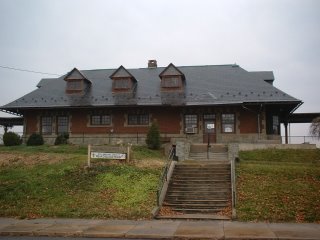
While visiting the CVS in Greencastle PA last week I visited the town train station. Now the headquarters of the local Scouts it's a beautiful example of 1900 train station design.
The Scout headquarters occupies a building erected by the Cumberland Valley Railroad as a passenger station in the course of the construction of its double-track "highline" through Greencastle in the period of 1906-1908. Prior to that time, since railroad service to the town began in 1839, all freight and passenger traffic had followed a route along Carlisle Street through the Public Square.
The first passenger station was on the west side of the Square in the north part of what was known as the Western Auto Store, owned by Carl Carbaugh. Later it was moved to the site of what is now the Citizens National Bark building on the east side of North Carlisle Street, where it remained until 1900, when a new station was built on the site of what until recently was the Dr. G. A. Sowell home on the west side of North Carlisle Street.
On February 5, 1906, for a consideration of $10,000, Greencastle's borough council granted the Railroad permission to build the "highline" along a route just west of Jefferson Street, the new line to accommodate all except local freight traffic. The project involved construction of the overhead head bridge at the north end of town and overpasses on Franklin, Baltimore, and Madison Streets as well as construction of a new passenger station near the intersection of Baltimore and Jefferson Streets.
The new station, representing the latest in passenger station design went into service on Sunday, February 7, 1909, at 12:45 p.m.., when passenger train No. 6, with Jacob Talhelm as engineer and Jacob Stouffer as conductor pulled up at the station on the northbound track as nearly 500 people cheered.
Built of brick and stone, the new station had a flaring canopy over the platform to the west, and a portico on the east side with steps descending toward Jefferson Street. The main approach was by a winding walk which led up the hill from Baltimore Street through the landscaped grounds. South of the Building was an open area for horse-drawn vehicles, railed to prevent them. from falling down the hill.
For more visit: http://www.greencastlemuseum.org/Local_History/scout_building.htm
No comments:
Post a Comment